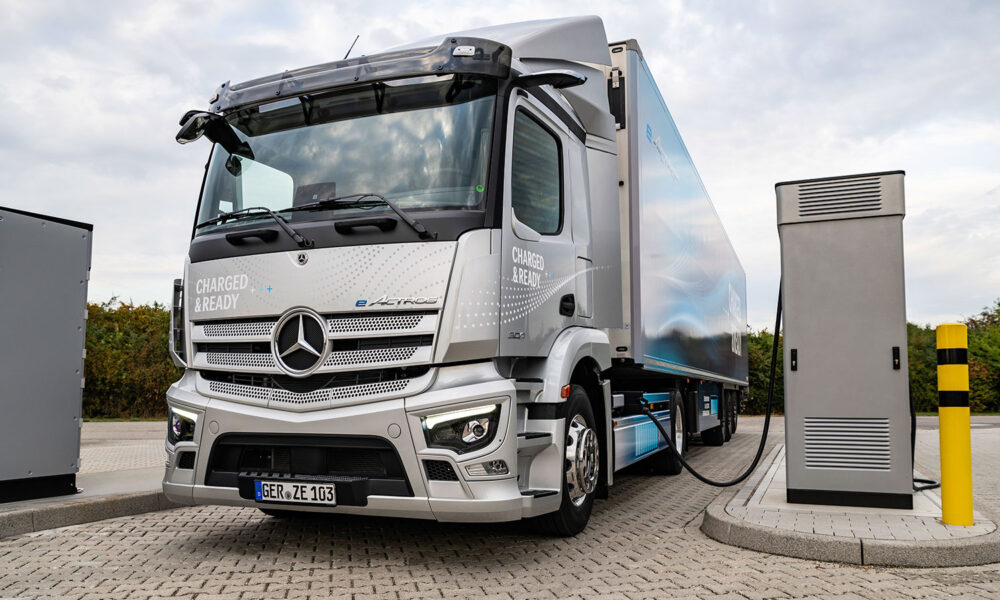We are about to enter the era of the electric truck. Sure, there are already a few thousand electric trucks and buses on US roads already. Now, with the California Air Resources Board’s passage of the Advanced Clean Fleets Rule in May and with the potential for a (hopefully) stronger-than-proposed greenhouse gas standard for heavy-duty trucks passed by the US Environmental Protection Agency (EPA) in the coming months, we will begin to see a significant switch from highly-polluting diesel trucks to zero-emission trucks. Those zero emission trucks can’t come soon enough. Communities that have been suffering from disproportionate exposure to transportation pollution, including diesel truck exhaust, have waited far too long to get relief.
There has been, understandably, some anxiety about where all of these trucks will charge and how the electric grid will serve that new electrical load. As I wrote in a previous post, the grid can handle the EV charging loads we have now. And it can support widespread EV adoption—of both passenger cars and heavy trucks—if we prepare well as EV adoption ramps up. Let’s dig in on what preparing well looks like for heavy truck charging.
Most trucks will charge at home base
A sensible place to start—and indeed where most truck and bus charging will take place—is at the vehicles’ home base (aka depot). Depots are large lots and garages where truck and bus fleets—such as school and transit buses, delivery vehicles, refuse trucks, and many others—are stored when not in use. Even one-third of tractor-trailers do the kind of shorter, local or regional freight hauling that allows them to return to base each day.
Fleet operators need to initiate depot charging installations with lead time sufficient to complete the project ahead of or at the same time as trucks are delivered. In addition to site engineering, permitting, construction, and interconnection schedules, another good reason to plan ahead has to do with the time required to explore different options that may reduce costs. For example, a fleet operator may choose a one-to-one vehicle-to-charger ratio using lower-powered chargers, or the fleet might choose to have fewer, higher-powered chargers that fleet vehicles share. What’s better for the fleet depends on the duty cycle of those vehicles, the cost difference, space availability, and other factors. Fleet operators may find that the depot fits fewer vehicles when accommodating space for charging equipment, or that an alternative location is preferable due to space or electrical capacity constraints.
Some fleet operators may, alternatively, prefer to outsource the logistics of depot charging, choosing to hire a company that provides charging as a service, where the provider manages the installation and operation of the chargers in exchange for a fee. In addition to covering the logistics, charging-as-a-service arrangements can serve as an alternative to the fleet operator financing the upfront cost of charging. Under such an arrangement, the operator would effectively to contribute to those costs over time through the service fee.
With some lead time, fleet operators can sort through all of these issues to take advantage of the lower cost of ownership that many truck models offer now or will over very soon in the future. Funding and tax credits available at the federal and state level, as well as programs from electric utilities, can also help with the upfront cost of truck and bus charging and further improve the total cost of ownership.
Some trucks will charge at shared and public chargers
Some vehicles will need public charging or shared private charging at sites on the truck’s route due to lack of a home depot, the intense demands of the trucks’ duty cycle, or both. For example, an independent drayage truck driver, who makes short haul freight runs in his tractor-trailer between the port and a warehouse, might be best served by charging equipment installed on their route so that the driver can top off the truck’s charge while freight is loaded or unloaded. That charging equipment might be privately operated behind a fence at the port or warehouse, but it can be shared among all of the trucks that stop at the sites as part of their work. With the majority of trucks operating less than 100 miles per day on fixed routes, charging on-route at work stops could accommodate many different truck vocations.
Long haul trucks are an example of a truck vocation that needs public charging akin to the fueling available at a conventional truck stop. Building out heavy-duty truck charging along freight corridors will make electric trucks a viable option for more truck operators on more truck routes. However, there is a bit of a chicken and egg problem with very high-powered (megawatt level) public charging for trucks, similar to that problem for public charging for passenger vehicles, just bigger. Long haul trucking operations may be interested in adopting electric models but are holding back for lack of very high-powered public charging. Meanwhile, would-be truck charging station owners might be holding back from investing significant amounts of money in such charging, uncertain how many users they will have. Another holdup has been the lack of a charging port standard for the megawatt power level charging.
But there is good news on this front. The industry expects to finalize the Megawatt Charging System in 2024, which would provide the specifications for everything from the configuration of pins in the charging connector to the placement of the port on the tractor. Tesla has also developed its Megacharger system, which it is deploying on its semi-truck, as well as the Cybertruck. Even at such high power, recharging the enormous batteries in long haul trucks will take some time. In many cases, that time will fit within the rest requirements for a truck driver’s work cycle, making use of time the truck would be parked anyway.
The other good news is that there are many government and utility programs as well as private-sector commitments to help fund the charging infrastructure we need at ports, warehouses, truck stops, and other locations. For examples, here, here, and here.
The grid can serve truck charging needs with smart planning
Whether electric grid operators can deploy grid upgrades by the time those are needed is a separate question. Individual charging projects can take years to complete, and grid upgrades to expand capacity to serve installations consisting of a large numbers of EV chargers with very high power demands at a site can take much longer, particularly where regional transmission grid infrastructure is concerned. We need policies and practices for proactive upgrades to reduce the bottlenecks we have seen and those we anticipate could come to pass if we continue with the status quo.
There is good news on this front, too. Grid operators around the country are beginning to incorporate EV planning into existing planning structures. In Minnesota, for example, the state’s Public Utilities Commission (PUC), has shifted investor-owned utilities’ transportation electrification planning and reporting requirements to the integrated distribution planning process to account for increasing linkages between EV planning and distribution system planning. Incorporating EV planning in existing planning structures can help ensure that those processes account for EV adoption and increase coordination across the business units of the utility companies. Combined planning processes can also create administrative efficiencies that help expedite time-sensitive planning needs.
As states advance toward widespread adoption, many will benefit from changing current policies for so-called “just-in-time” grid upgrades—which result in larger charging projects being completed too late relative to vehicle delivery—to something much more proactive and practical. The California Public Utilities Commission has begun developing a framework to do just that for freight infrastructure in anticipation of a ramp-up in trucks to meet the Advanced Clean Trucks and Advanced Clean Fleet Standards. The California PUC’s Freight Infrastructure Planning aims to generate locally granular, “investment grade” forecasts of electric truck charging so that utilities can proactively build the grid to accommodate those EV loads. In other words, electric utilities can make it easier for truck fleets to go electric by anticipating and investing in the needed distribution grid upgrades that require long lead times before the requests for from fleet operators for new or additional service to serve truck charging, instead of having to be reactive to those requests.
On the transmission planning side, regional grid operators, such as the Midcontinent Independent System Operator, have already begun to think about how transportation electrification will impact total energy needs and the timing of annual peaks in electricity demand. Still there is a ways to go in increasing the ambition of grid planning efforts. Strong vehicle standards can give grid operators a more certain and appropriately ambitious EV forecast against which to plan grid investments.
Smart charging and other vehicle grid integration practices can help, too
Vehicle-grid integration (VGI) strategies are critical to infrastructure planning for trucks. VGI refers to how EVs become part of the complex electric power system through both managing how EVs are charged and, for bidirectional charging-capable EV, managing how energy stored in an EV can be used to power other things, such as providing backup power or putting energy back on the electricity grid.
VGI can also be used to reduce the need for upgrades that would otherwise be necessary. In the simplest case, managing truck charging loads to shift them away from peak demand times for the grid as a whole and/or on the local distribution circuit can reduce the size of the grid upgrade needed to serve charging needs at particular site. That is because the grid has to be built up to accommodate peak demand—the moment of highest electricity use for the year. The potential for VGI to reduce the need for grid upgrades can be enhanced where electric trucks are able to export power back to the grid at peak times (while prioritizing the needs of the truck duty cycle, of course). In this way, intentional VGI, even in its simple forms, can help reduce the scale of the infrastructure deployment challenge.
Time to move faster
There is no time to waste in making the investments needed to ensure electric trucks can be put into operation at scale and get diesel trucks off the road as soon as possible. The imperative to reduce health harming pollution in the most affected communities and to curb climate-warming emission requires it. Some progress has been made. Now it is time to move faster, and UCS will continue to push for ambitious planning and increased investment in a clean truck future on all fronts.

